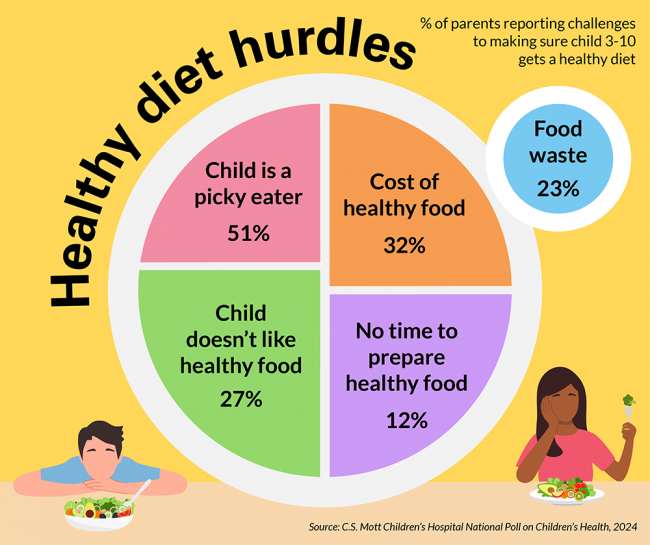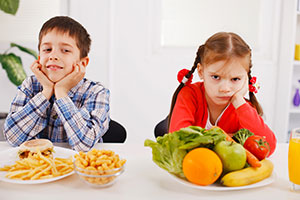Balancing act: Providing a healthy diet for children


Balancing act: Providing a healthy diet for children
A balanced diet helps keep children healthy as they develop, providing energy and nutrients to grow and thrive. The C.S. Mott Children’s Hospital National Poll on Children’s Health asked a national sample of parents of children 3-10 years about food and diet choices they make for their child.
One-third of parents (32%) think the standard American diet is healthy for children, compared to 47% for a Mediterranean diet, 31% for vegetarian, 22% for plant-based/vegan, and 13% for keto/low-carb diet. Some parents report trying alternate diets for their child including 8% Mediterranean, 9% vegetarian, 6% plant-based/vegan, and 4% keto/low-carb diet.
When grocery shopping or planning meals, parents say they try to limit the amount of certain foods to help their child to maintain a healthy diet, including limiting foods with added sugars (59%), processed foods (54%), fat (17%) or meat (8%). Nearly all parents (94%) report trying at least one strategy to get their child to eat vegetables as part of a healthy diet, such as serving vegetables every day (59%), fixing vegetables how their child prefers (53%), trying vegetables their child hasn’t had before (41%), letting their child pick out vegetables at the grocery store (41%) or help prepare the vegetables (25%), hiding vegetables in other foods (25%), or offering a reward for finishing vegetables (19%).
In determining portion size for their child, most parents (69%) give their child slightly less than adults in the family; fewer parents let their child choose how much to take (23%), use predetermined portions from the package (5%), or give their child the same portions as adults (3%). Only 15% of parents say their family rule is that you have to finish what’s on your plate, while 54% say you must try some of everything and 31% say no dessert if you don’t finish dinner. Most parents (71%) allow their child to have seconds, although some parents say only if their child finishes everything on their plate (21%) or only for healthy items (6%). Sixty-one percent of parents say that they will make something different if their child doesn’t like what other family members are eating.
Parents describe their biggest challenges with making sure their child gets a healthy diet as the child being a picky eater (51%), cost of healthy food (32%), child not liking healthy food (27%), food waste (23%), and not having time to prepare healthy food (12%).

Highlights
- 1 in 3 parents think that the standard American diet is healthy for children age 3-10.
- 1 in 8 parents make their child finish everything on their plate.
- 3 in 5 parents will make something different if their child does not like what other family members are eating.
Implications
Feeding young children can be difficult due to their general avoidance of unfamiliar foods and their frequently changing food preferences. The preschool and elementary age is an important time to establish healthy habits around eating patterns and taste preferences, yet parents often wonder whether their child is eating enough and getting the nutrients they need.
Only one-third of parents in this Mott Poll rated the standard American diet as healthy for children; this may reflect parent recognition that the standard American diet is characterized by high amounts of saturated fats, added sugars, sodium, and refined carbohydrates, which can generate an excess intake of calories beyond nutritional needs. This can contribute to excess weight and weight-related illnesses.
Family dining rules can promote or hinder a child’s healthy diet. Experts often recommend that “parents provide, and the child decides”; this means that parents are responsible for providing healthy options, allowing the child to select which foods they will eat and the amount they want to consume. Requiring children to eat everything on their plate, or withholding dessert unless all other foods are eaten, can lead to overconsumption, especially if portion sizes are too large for the child’s age. Portion size is key to mitigating the risk of childhood obesity, but it can be hard for parents to “right-size” a child portion. The U.S. Department of Agriculture provides a visual called MyPlate that can help parents estimate the recommended balance of the major food groups and offers guidance on estimating portion size.
An important role for parents is to make good choices when grocery shopping so that children have healthy options for meals and snacks. Many parents are not using this approach. Parents may have difficulty identifying unhealthy food, since added sugars or processing may be reflected in foods marketed as healthy options. Some parents may be unaware of the extent to which certain foods can negatively impact their child’s long-term health, such as the link between “ultra-processed” foods and an increased risk of developing obesity, type 2 diabetes and heart disease. In other situations, parents may give in to their child’s request for unhealthy foods or prefer those foods themselves.
Vegetables contain a variety of essential nutrients, but parents often face challenges with getting their child to eat them. Offering vegetables daily helps build familiarity. Including children in choosing and preparing vegetables, as well as creative presentation or use of healthy dips, may convince children to try a vegetable they initially resist. Parents should be persistent in the hope that over time, children will become more open to eating vegetables regularly.
Many parents will make something separate if their child doesn’t like what the rest of the family is eating, but often the alternative food is less healthy. Rather than allowing the child to choose an alternate menu, parents should provide a balanced meal and encourage the child to try at least a small amount of healthy foods that might not be their preference. And since children learn through watching and imitating, parents should model the behavior of eating a well-balanced diet while their child’s eating habits and taste preferences mature.
Some parents view Mediterranean, vegetarian, or plant-based diets as healthy alternatives, but relatively few have tried them for their child. Parents may be unsure if these diets provide adequate nutrition for young children or feel uncertain about how to ensure such diets fulfill a child’s nutrient needs. In particular, for diets that limit animal products, parents will need to ensure their child gets enough protein through alternative sources such as meat substitutes, tofu, or legumes.
Although ketogenic diets have become popular among adults, they are generally not appropriate for children. Ketogenic diets are helpful in treating certain forms of epilepsy; outside of that specific situation, parents should avoid giving children a ketogenic diet as it puts them at risk for deficiencies in the nutrients they need to grow and thrive.

Data Source & Methods
This report presents findings from a nationally representative household survey conducted exclusively by Ipsos Public Affairs, LLC (Ipsos) for C.S. Mott Children’s Hospital. The survey was administered in February 2024 to a randomly selected, stratified group of adults who were parents of at least one child age 0-18 years living in their household (n=2,057). Adults were selected from Ipsos’s web-enabled KnowledgePanel® that closely resembles the U.S. population. The sample was subsequently weighted to reflect population figures from the Census Bureau. The survey completion rate was 61% among panel members contacted to participate. This report is based on responses from 1,083 parents with at least one child age 3-10. The margin of error for results presented in this report is ±1 to 3 percentage points.
Findings from the C.S. Mott Children’s Hospital National Poll on Children’s Health do not represent the opinions of the University of Michigan. The University of Michigan reserves all rights over this material.
Citation
Woolford SJ, Ewing L, Schultz SL, Gebremariam A, Freed GL, Clark SJ. Balancing act: Providing a healthy diet for children. C.S. Mott Children's Hospital National Poll on Children's Health, University of Michigan. Vol 45, Issue 2, April 2024. Available at: https://mottpoll.org/reports/balancing-act-providing-healthy-diet-children.


